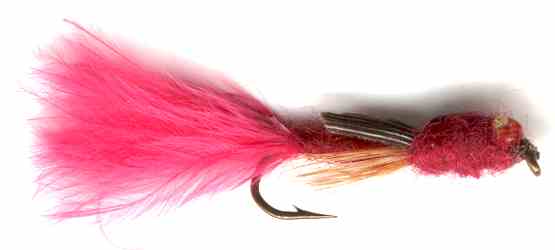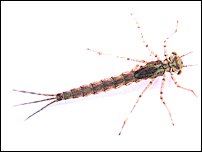Claret Glass Eyed Damsel Nymph Fly
The Claret Glass Eyed Damsel Nymph. The damsel fly nymph swims by a rapid lashing movement of its abdomen unlike the closely relater dragon fly nymph which achieves propulsion by forcing water out of its backside. For an imitation to be effective it hast to have a lot of rear end movement.

DAMSEL NYMPH FLY PATTERNS. Hook size 10- $US each
SUMMER FLYFISHING WITH DAMSEL NYMPHS
Yes I know you are itching to start fishing as soon as you get on the river bank, but stop. Take time to observe what the fish are doing. Fishing with damsel fly patterns is more successful if you are patient and take time to observe the water, rather than just casting blindly. This time is never wasted. It can reveal some surprising things. Look for where trout are sipping down the emerging damsel nymphs as they try to hatch into adult damsels. Look near the section of the bank that has abundant vegetation. Damsel nymphs are crawlers. They use semi submerged plants to help crawl up out of the water and also as a resting place to wait until their wings are fully developed after hatching. You should be looking for feeding activity near these natural features.
When you see feeding activity near aquatic vegetation or riverside plants then tie on a damsel nymph as the nymphs that are yet to hatch will be very active subsurface. Do not be an idiot and rush to the water’s edge and start to cast in your excitement. The fish will see you. They are already looking upwards in their search for food. You will be spotted and spook them. Stay low and away from the river bank edge. Move upstream away from your target area out of the trout’s vision and cast to them. They will stay in the same location until the food source has gone or they are scared away. Try to feather the cast onto the water as gently as you can so you do not scare them. Time spent practicing this skill is very worth will so you can succeed in situations like this.

Try to fish into the target feeding area by casting to the margins and work out to your maximum casting range five feet at a time. Seriously consider if wading is the best tactic. So many fly fishermen spoil their day’s sport by rushing into the water. If you consider that to get the best angle you must wade into the river then do so slowly and a long way away from your target area. Take your time to move nearer and try not to make too much of a disturbance.
I like to use a 5-6wt outfit when fishing single damsel flies for trout. I find it enabled me to give a delicate presentation. I use a floating line rather than a sinking line as during a hatch the other damsel nymph activity is very near the surface. You often have to set the hook at close ranges therefore I would recommend using a middle-action rod to give you more control. Think of the way the natural insect behaves in the water when retrieving the fly. Keep your retrieve slow. They are not Olympic swimmers. You will scare away the trout if they suddenly detect unnatural movement near them. Nymphs that suddenly move as fast as speed boats look wrong. You are trying to imitate a small invertebrate aquatic insect that swims in small jerky movements.
Use a figure of eight slow retrieve that is interspersed with a pause and the odd small jerk. Try to start each pull slowly and gradually build up speed then stop. This should encourage nearby fish to come over and investigate. As you start your next pull be prepared for a take as you may have trout following your damsel nymph fly.


Fly Fishing books

